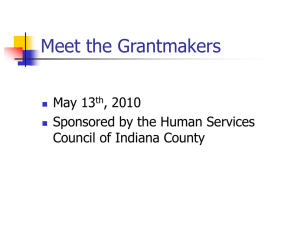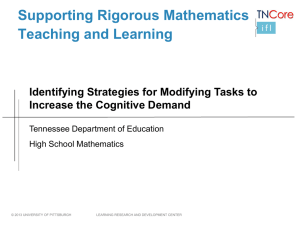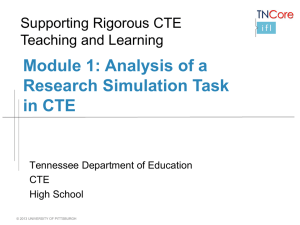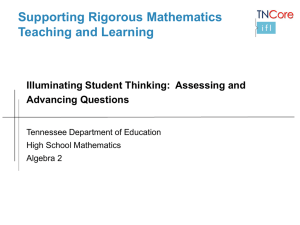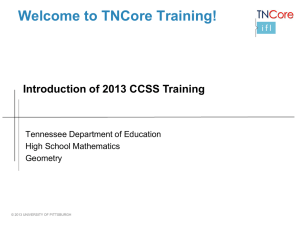Supporting Student Learning of Mathematics
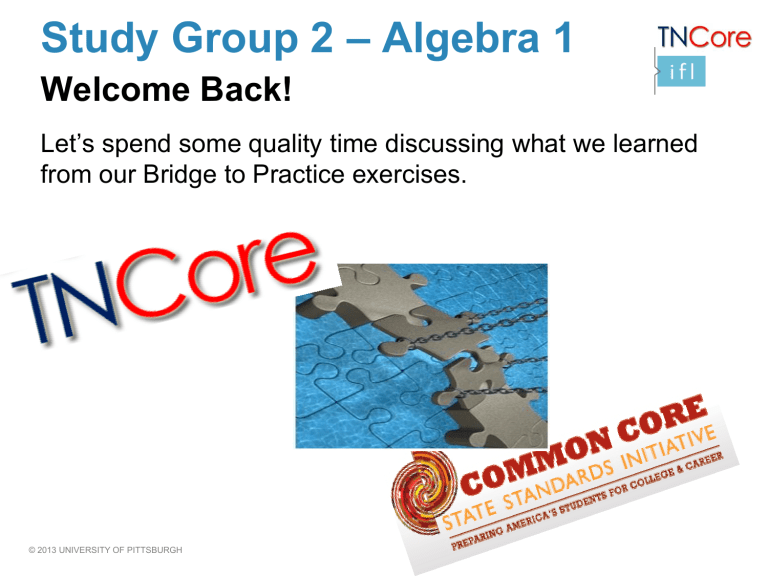
Study Group 2 – Algebra 1
Welcome Back!
Let’s spend some quality time discussing what we learned from our Bridge to Practice exercises.
© 2013 UNIVERSITY OF PITTSBURGH
Part A From Bridge to Practice #1:
Practice Standards
Choose the Practice Standards students will have the opportunity to use while solving these tasks we have focused on and find evidence to support them.
Using the Assessment to Think About Instruction
In order for students to perform well on the CRA, what are the implications for instruction?
• What kinds of instructional tasks will need to be used in the classroom?
• What will teaching and learning look like and sound like in the classroom?
Complete the Instructional Task
Work all of the instructional task “Bike and Truck Task” and be prepared to talk about the task and the CCSSM Content and Practice Standards associated with it.
© 2013 UNIVERSITY OF PITTSBURGH
The CCSS for Mathematical Practice
1.
Make sense of problems and persevere in solving them.
2.
Reason abstractly and quantitatively.
3.
Construct viable arguments and critique the reasoning of others.
4.
Model with mathematics.
5.
Use appropriate tools strategically.
6.
Attend to precision.
7.
Look for and make use of structure.
8.
Look for and express regularity in repeated reasoning.
© 2013 UNIVERSITY OF PITTSBURGH
Common Core State Standards for Mathematics, 2010, NGA Center/CCSSO
3
1. Buddy Bags
For a student council fundraiser, Anna and Bobby have spent a total of $55.00 on supplies to create Buddy Bags. They plan to charge
$2.00 per Buddy Bag sold.
Anna created the graph below from an equation to represent the profit from the number of Buddy Bags sold.
a. Determine the equation Anna used to create the graph if x represents the number of Buddy Bags sold and y represents the profit in dollars. Use mathematical reasoning to explain your equation.
b.
Bobby claims that Anna’s graph is incorrect because it does not show that they plan to charge $2.00 per Buddy Bag. Do you agree or disagree with Bobby? Use mathematical reasoning to support your decision.
c.
Anna says, “I connected the points to represent the equation, but by connecting the points I am not representing the context of the problem.”
Use mathematical reasoning to explain why she is correct.
© 2013 UNIVERSITY OF PITTSBURGH
-30
-40
-50
-60
20
10
0
-10
0
-20
70
60
50
40
30
10 20 30 40 50
Number of Buddy Bags Sold
60
2. Disc Jockey Decisions
The student council has asked Dion to be the disc jockey for the Fall
Banquet. He has been asked to play instrumental music during the first hour while the students are eating dinner. During the last 15 minutes of the banquet the school choir will sing. For the remaining time, Dion will choose popular songs to play.
a.
Write an equation to determine the number of popular songs, p , that
Dion can choose if the songs Dion chooses have an average run time of 3.5 minutes and the total time for the Fall Banquet is t minutes. Use mathematical reasoning to justify that your equation is correct.
b.
Use your equation from Part a to determine the number of popular songs that Dion can choose if the banquet will be held from 6:00 –
10:00pm.
c.
Dion decides to organize the music another way. He decides to play 50 popular songs. Write and solve an algebraic equation to determine the average run time, r , of the 50 popular songs Dion can choose if the average run time is represented in minutes by r . Use mathematical reasoning to justify that your equation is correct.
© 2013 UNIVERSITY OF PITTSBURGH
Part B from Bridge to Practice #1:
Practice Standards
Choose the Practice Standards students will have the opportunity to use while solving these tasks we have focused on and find evidence to support them.
Using the Assessment to Think About Instruction
In order for students to perform well on the CRA, what are the implications for instruction?
• What kinds of instructional tasks will need to be used in the classroom?
• What will teaching and learning look like and sound like in the classroom?
Complete the Instructional Task
Work all of the instructional task “Bike and Truck Task” and be prepared to talk about the task and the CCSSM Content and Practice Standards associated with it.
© 2013 UNIVERSITY OF PITTSBURGH
Part C From Bridge to Practice #1:
Practice Standards
Choose the Practice Standards students will have the opportunity to use while solving these tasks we have focused on and find evidence to support them.
Using the Assessment to Think About Instruction
In order for students to perform well on the CRA, what are the implications for instruction?
• What kinds of instructional tasks will need to be used in the classroom?
• What will teaching and learning look like and sound like in the classroom?
Complete the Instructional Task
Work all of the instructional task “Bike and Truck Task” and be prepared to talk about the task and the CCSSM Content and Practice
Standards associated with it.
© 2013 UNIVERSITY OF PITTSBURGH
Supporting Rigorous Mathematics
Teaching and Learning
Engaging In and Analyzing Teaching and
Learning through an Instructional Task
Tennessee Department of Education
High School Mathematics
Algebra 1
© 2013 UNIVERSITY OF PITTSBURGH
Rationale
By engaging in an instructional task , teachers will have the opportunity to consider the potential of the task and engagement in the task for helping learners develop the facility for expressing a relationship between quantities in different representational forms , and for making connections between those forms .
Question to Consider…
What is the difference between the following types of tasks?
• instructional task
• assessment task
© 2013 UNIVERSITY OF PITTSBURGH
Taken from TNCore’s FAQ Document:
© 2013 UNIVERSITY OF PITTSBURGH
Session Goals
Participants will:
•
develop a shared understanding of teaching and learning through an instructional task; and
•
deepen content and pedagogical knowledge of mathematics as it relates to the Common Core State
Standards (CCSS) for Mathematics.
(This will be completed as the Bridge to Practice)
© 2013 UNIVERSITY OF PITTSBURGH
Overview of Activities
Participants will:
• engage in a lesson; and
• reflect on learning in relationship to the CCSS.
(This will be completed as the Bridge to Practice #2)
© 2013 UNIVERSITY OF PITTSBURGH
Looking Over the Standards
• Briefly look over the focus cluster standards.
• We will return to the standards at the end of the lesson and consider:
What focus cluster standards were addressed in the lesson?
What gets “counted” as learning?
© 2013 UNIVERSITY OF PITTSBURGH
Bike and Truck Task
A bicycle traveling at a steady rate and a truck are moving along a road in the same direction. The graph below shows their positions as a function of time. Let
B(t) represent the bicycle’s distance and K(t) represent the truck’s distance.
© 2013 UNIVERSITY OF PITTSBURGH
Time (in seconds)
The Structures and Routines of a Lesson
Set Up of the Task
The Explore Phase/Private Work Time
Generate Solutions
The Explore Phase/Small Group Problem
Solving
1. Generate and Compare Solutions
2. Assess and Advance Student Learning
Share, Discuss, and Analyze Phase of the Lesson
1. Share and Model
2. Compare Solutions
3. Focus the Discussion on
Key Mathematical Ideas
4. Engage in a Quick Write
MONITOR: Teacher selects examples for the Share,
Discuss, and Analyze Phase based on:
• Different solution paths to the same task
• Different representations
• Errors
• Misconceptions
SHARE: Students explain their methods, repeat others ’ ideas, put ideas into their own words, add on to ideas and ask for clarification.
REPEAT THE CYCLE FOR EACH
SOLUTION PATH
COMPARE: Students discuss similarities and difference between solution paths.
FOCUS: Discuss the meaning of mathematical ideas in each representation
REFLECT: B y engaging students in a quick write or a discussion of the process.
Solve the Task
(Private Think Time and Small Group Time)
•
Work privately on the Bike and Truck Task.
(This should have been completed as the Bridge to
Practice prior to this session)
•
Work with others at your table. Compare your solution paths. If everyone used the same method to solve the task, see if you can come up with a different way.
•
Consider the information that can be determined about the two vehicles.
© 2013 UNIVERSITY OF PITTSBURGH
Expectations for Group Discussion
•
Solution paths will be shared.
•
Listen with the goals of :
– putting the ideas into your own words;
– adding on to the ideas of others;
– making connections between solution paths; and
– asking questions about the ideas shared.
•
The goal is to understand the mathematics and to make connections among the various solution paths .
© 2013 UNIVERSITY OF PITTSBURGH
Bike and Truck Task
A bicycle traveling at a steady rate and a truck are moving along a road in the same direction. The graph below shows their positions as a function of time. Let
B(t) represent the bicycle’s distance and K(t) represent the truck’s distance.
© 2013 UNIVERSITY OF PITTSBURGH
Time (in seconds)
Bike and Truck Task
1. Label the graphs appropriately with B(t) and K(t).
Explain how you made your decision.
2. Describe the movement of the truck. Explain how you used the values of B(t) and K(t) to make decisions about your description.
3. Which vehicle was first to reach 300 feet from the start of the road? How can you use the domain and/or range to determine which vehicle was the first to reach 300 feet? Explain your reasoning in words.
4. Jack claims that the average rate of change for both the bicycle and the truck was the same in the first 17 seconds of travel. Explain why you agree or disagree with Jack.
© 2013 UNIVERSITY OF PITTSBURGH
Discuss the Task
(Whole Group Discussion)
• How did you describe the movement of the truck, as opposed to that of the bike? What information from the graph did you use to make those decisions?
• In what ways did you use the information you determined about the two vehicles to determine which vehicle was first to reach 300 feet from the start of the road?
• When, if ever, is the average rate of change the same for the two vehicles?
© 2013 UNIVERSITY OF PITTSBURGH
Reflecting on Our Learning
• What supported your learning?
• Which of the supports listed will
EL students benefit from during instruction?
© 2013 UNIVERSITY OF PITTSBURGH
Linking to Research/Literature
Connections between Representations
Pictures
Manipulative
Models
Written
Symbols
Real-world
Situations
Oral
Language
Adapted from Lesh, Post, & Behr, 1987
Five Different Representations of a Function
Language
Context Table
Van De Walle, 2004, p. 440
Graph Equation
The CCSS for Mathematical Content
CCSS Conceptual Category – Algebra
Creating Equations* (A –CED)
Create equations that describe numbers or relationships.
A-CED.A.1
A-CED.A.2
A-CED.A.3
A-CED.A.4
Create equations and inequalities in one variable and use them to solve problems.
Include equations arising from linear and quadratic functions, and simple rational and exponential functions.
Create equations in two or more variables to represent relationships between quantities; graph equations on coordinate axes with labels and scales.
Represent constraints by equations or inequalities, and by systems of equations and/or inequalities, and interpret solutions as viable or nonviable options in a modeling context.
For example, represent inequalities describing nutritional and cost constraints on combinations of different foods.
Rearrange formulas to highlight a quantity of interest, using the same reasoning as in solving equations.
For example, rearrange
Ohm’s law V = IR to highlight resistance R.
*Mathematical Modeling is a Standard for Mathematical Practice (MP4) and a Conceptual Category, and specific modeling standards appear throughout the high school standards indicated with a star ( ★ ). Where an entire domain is
Common Core State Standards, 2010, p. 65, NGA Center/CCSSO
The CCSS for Mathematical Content
CCSS Conceptual Category – Algebra
Reasoning with Equations and Inequalities (A
–REI)
Solve equations and inequalities in one variable.
A-REI.B.3
Solve linear equations and inequalities in one variable, including equations with coefficients represented by letters.
A-REI.B.4
Solve quadratic equations in one variable.
A-REI.B.4a
Use the method of completing the square to transform any quadratic equation in x into an equation of the form ( x – p ) 2 = q that has the same solutions. Derive the quadratic formula from this form.
A-REI.B.4b
Solve quadratic equations by inspection (e.g., for x 2 = 49), taking square roots, completing the square, the quadratic formula and factoring, as appropriate to the initial form of the equation. Recognize when the quadratic formula gives complex solutions and write them as a ± bi for real numbers a and b .
© 2013 UNIVERSITY OF PITTSBURGH
Common Core State Standards, 2010, p. 65, NGA Center/CCSSO
The CCSS for Mathematical Content
CCSS Conceptual Category – Algebra
Reasoning with Equations and Inequalities (A
–REI)
Represent and solve equations and inequalities graphically.
A-REI.D.10
Understand that the graph of an equation in two variables is the set of all its solutions plotted in the coordinate plane, often forming a curve
(which could be a line).
A-REI.D.11
Explain why the x -coordinates of the points where the graphs of the equations y = f ( x ) and y = g ( x ) intersect are the solutions of the equation f ( x ) = g ( x ); find the solutions approximately, e.g., using technology to graph the functions, make tables of values, or find successive approximations. Include cases where f ( x ) and/or g ( x ) are linear, polynomial, rational, absolute value, exponential, and logarithmic functions .
★
A-REI.D.12
Graph the solutions to a linear inequality in two variables as a halfplane (excluding the boundary in the case of a strict inequality), and graph the solution set to a system of linear inequalities in two variables as the intersection of the corresponding half-planes.
★
Mathematical Modeling is a Standard for Mathematical Practice (MP4) and a Conceptual Category, and specific modeling standards appear throughout the high school standards indicated with a star (
★
). Where an entire domain is
Common Core State Standards, 2010, p. 65, NGA Center/CCSSO
The CCSS for Mathematical Content
CCSS Conceptual Category – Functions
Interpreting Functions (F –IF)
Interpret functions that arise in applications in terms of the context.
F-IF.B.4
For a function that models a relationship between two quantities, interpret key features of graphs and tables in terms of the quantities, and sketch graphs showing key features given a verbal description of the relationship.
Key features include: intercepts; intervals where the function is increasing, decreasing, positive, or negative; relative maximums and minimums; symmetries; end behavior; and periodicity.
★
F-IF.B.5
Relate the domain of a function to its graph and, where applicable, to the quantitative relationship it describes.
For example, if the function h(n) gives the number of person-hours it takes to assemble n engines in a factory, then the positive integers would be an appropriate domain for the function.
★
F-IF.B.6
Calculate and interpret the average rate of change of a function (presented symbolically or as a table) over a specified interval. Estimate the rate of change from a graph.
★
★
Mathematical Modeling is a Standard for Mathematical Practice (MP4) and a Conceptual Category, and specific modeling standards appear throughout the high school standards indicated with a star (
★
)
. Where an entire domain is
Common Core State Standards, 2010, p. 69, NGA Center/CCSSO
Bridge to Practice #2:
Time to Reflect on Our Learning
1. Using the Bike and Truck Task: a. Choose the Content Standards from pages 11-12 of the handout that this task addresses and find evidence to support them.
b.
Choose the Practice Standards students will have the opportunity to use while solving this task and find evidence to support them.
2.
Using the quotes on the next page, write a few sentences to summarize what Tharp and Gallimore are saying about the learning process.
3.
Read the given Essential Understandings. Explain why I need to know this level of detail about rate of change in order to determine if a student understands the concept behind rate of change.
© 2013 UNIVERSITY OF PITTSBURGH
Research Connection: Findings by
Tharp and Gallimore
•
For teaching to have occurred Teachers must “be aware of the students’ ever-changing relationships to the subject matter.”
•
They [teachers] can assist because, while the learning process is alive and unfolding , they see and feel the student's progression through the zone , as well as the stumbles and errors that call for support.
•
For the development of thinking skills —the [students’] ability to form, express, and exchange ideas in speech and writing —the critical form of assisting learners is dialogue -- the questioning and sharing of ideas and knowledge that happen in conversation.
Tharp & Gallimore, 1991
© 2013 UNIVERSITY OF PITTSBURGH
Underlying Mathematical Ideas Related to the Lesson (Essential Understandings)
• The language of change and rate of change (increasing, decreasing, constant, relative maximum or minimum) can be used to describe how two quantities vary together over a range of possible values.
• A rate of change describes how one variable quantity changes with respect to another – in other words, a rate of change describes the covariation between two variables
(NCTM, EU 2b).
• The average rate of change is the change in the dependent variable over a specified interval in the domain. Linear functions are the only family of functions for which the average rate of change is the same on every interval in the domain.
© 2013 UNIVERSITY OF PITTSBURGH
